Fake and dangerous USB-C power supply
Also available in: Italiano 🇮🇹
Introduction
"When a law is made, a loophole is found"
And that is why even in A.D. 2025, such fake and dangerous USB power supplies continue to exist. They not only do not deliver the power stated on the box, but they also provide noisy output current, are unreliable over time and often are downright dangerous and can cause even fatal accidents.
The specimen in question
This power supply was bought on Vinted, an online buying and selling platform that recently inaugurated a new section dedicated entirely to electronics. Of course, they are also available on many other platforms, such as Aliexpress, eBay... but sometimes also from physical stores, even at rather high prices.
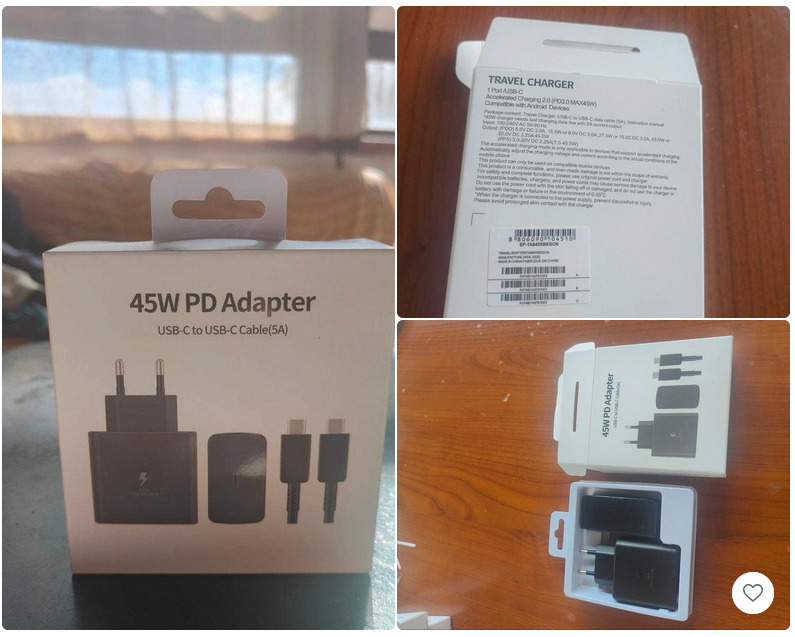
The technical characteristics are listed below. Here are the main ones:
- Maximum output power: 45W
- Maximum output voltage: 20V (PDO) or 21V (PPS)
- Maximum current: 3A
- 5A cable included (!)
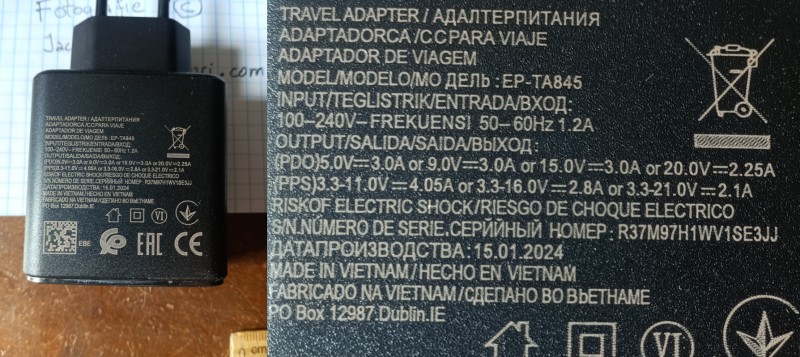
Even just by reading the features you start having some doubts: what's the point of providing a 5 amp cable, when the power supply with which it is included can only provide a maximum of 3A? The answer will come later...
Electrical analysis
USB protocols
Using a FNIRSI FNB58 multifunction USB tester you can quickly make some electrical measurements (not under load).
USB-C supports many output voltages and currents, so it is equipped with various signaling systems that the device being charged uses to tell the power supply which voltage and current to output.
USB-C supports the PDO and PPS protocols. In short:
- PDO supports four standard output voltages plus a non-standard one, which are: 5V, 9V, 12V (non-standard), 15V and 20V.
- PPS supports any voltage between the minimum and maximum range that the charger can provide, typically from 3.3V to 21V, but sometimes PPS goes up only to about 13V and PDO can go to 20V.
According to the specifications printed on the case, our power supply should support both PDO up to 20V (except 12V), and PPS up to 21V.
However, the tester clearly tells us that PDO only goes up to 12V, while PPS is not there at all!
The maximum power is only 33W, corresponding to 12V x 2.8A, but the actual power that can be supplied is even lower as we will see later!
Other inconsistencies are with the HUAWEI protocols, with SCP advertising a massive 66 watts from a supposedly 45 watt power supply!

Load curve
To verify the veracity of what USB Power Delivery claims, it is a good idea to perform a load test. The test was performed with a BK PRECISION 8600 electronic load in constant current mode, increasing the current in 100mA steps and reading the voltage on the USB output port (Kelvin method). The voltage is increased using the PD Trigger function of the FNIRSI FNB58 tester.
The result is not very exciting:
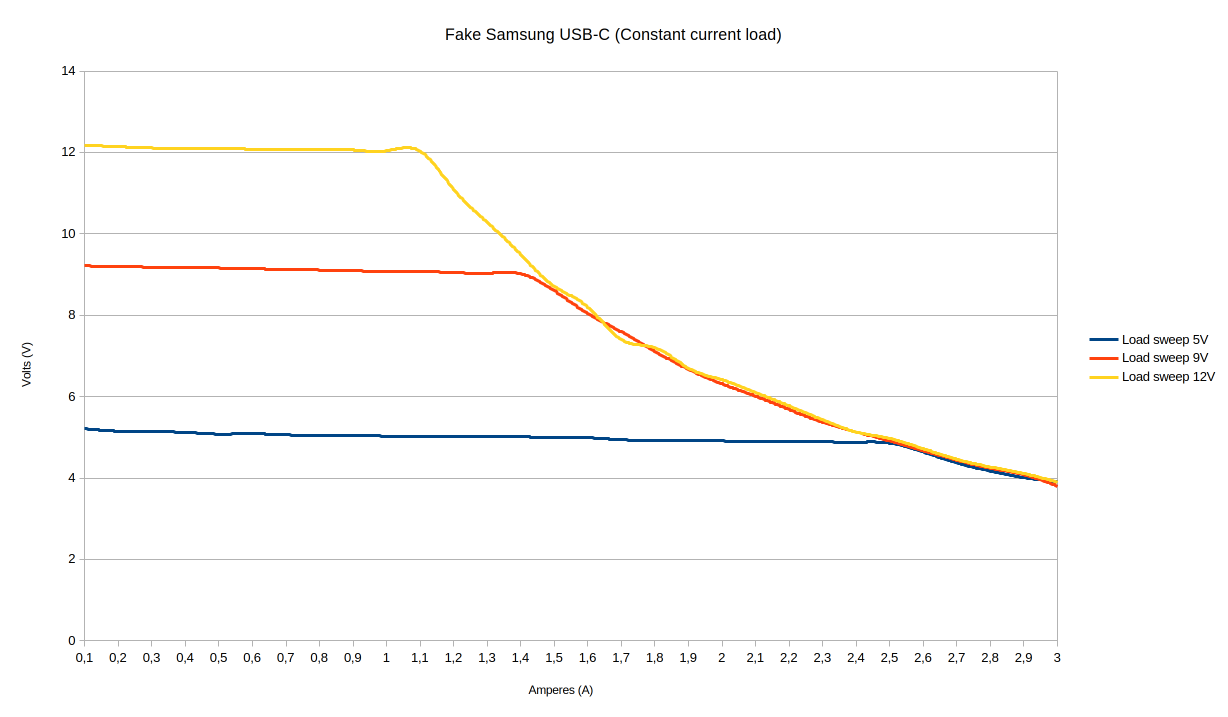
You can see that despite the increase in voltage, the maximum current delivered is reduced. In other words, power is the limiting factor. The power supply therefore seems to have a maximum power output of just 11 watts, a quarter of that advertised!
Thermal parameters and half-hour test
Setting the maximum power output at 11 watts as seen above, I performed a half-hour load test to determine the steady-state temperatures. To perform the test, the electronic load was set to constant power mode with a power of 11 watts.
Below are the thermographies taken with the FLIR Lepton sensor. The first image was taken with the power supply still connected by partially opening the case, while the second was taken by disconnecting the power supply and then extracting its circuit.
In both cases, the hottest point is the transformer, which reaches 90°C.
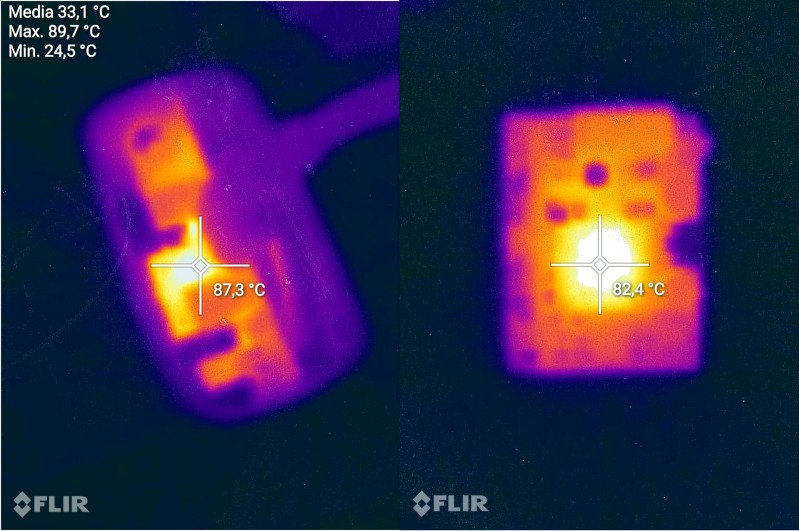
Galvanic Isolation
When performing the tests above by handling the tester I kept feeling minor electric shocks, which were sometimes unusually strong. So I decided to perform a galvanic isolation test.
IEC 60747 specifications stipulate that a device powered by 110V AC networks (e.g. USA) must have galvanic isolation capable of withstanding at least 2500V between primary (mains side) and secondary (low voltage side). For 230V networks, this value is increased to 5000V.
So I performed a 2500V test with DY30-2 insulation tester, which failed because the resistance was less than a gigaohm.

This means that the power supply is DANGEROUS and must not be used anywhere in the world.
A transient on the electrical network or humidity in the power supply could cause the mains voltage to reach the USB port and therefore the device being charged, killing or seriously injuring the unsuspecting user.
Remember that in the event of an electric shock, the muscles tend to close (tetanization), forcefully squeezing any conductor that has been picked up (in this case, the phone/tablet) thus making it impossible to let go of the object, unless there is external intervention (RCD/GFCI, a third person...).
Component analysis
After the galvanic isolation test has failed, it's time to open the power supply (there is no point in doing the output current quality tests, as the charger is too dangerous to be used).
Disassembly
The power supply was opened very easily by dropping it to the ground from a height of about 1 meter. The front is only wedged and not glued, so it doesn't take much effort to accidentally expose yourself to components.
The first thing you notice is a metal plate on the back of the printed circuit board, perhaps a heatsink?
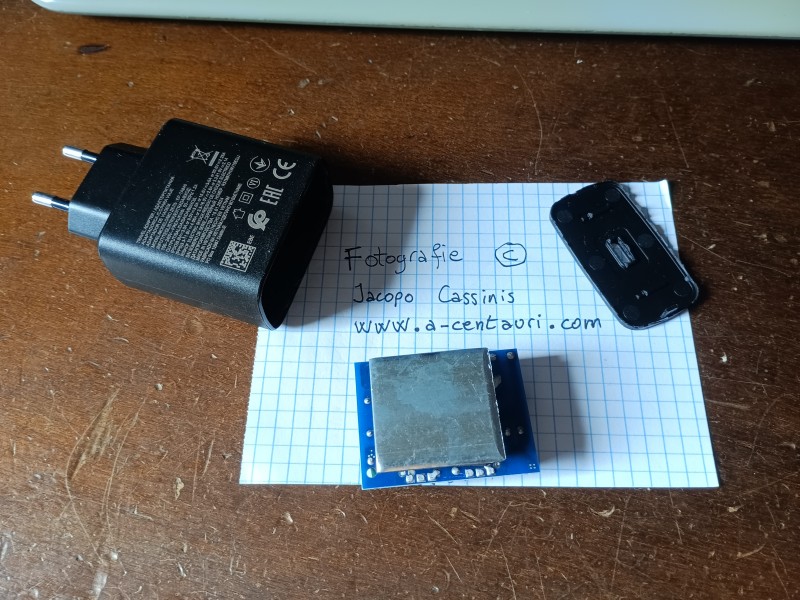
No, it is not a heatsink. It is literally a piece of iron glued with normal adhesive sponge to make the power supply heavier and therefore more convincing to the eyes (or rather, to the touch) of a potential buyer.

Isolation
The isolation test failed most likely because the sponge absorbed moisture. Since it is glued to the back of the PCB, the primary and secondary pins make contact with it.
However, even without the sponge, the situation does not improve. IEC 60747 also stipulates that in switching power supplies the distance between the secondary and primary on the printed circuit board (creepage distance) must not be less than four millimeters, but here we have a 50% discount...
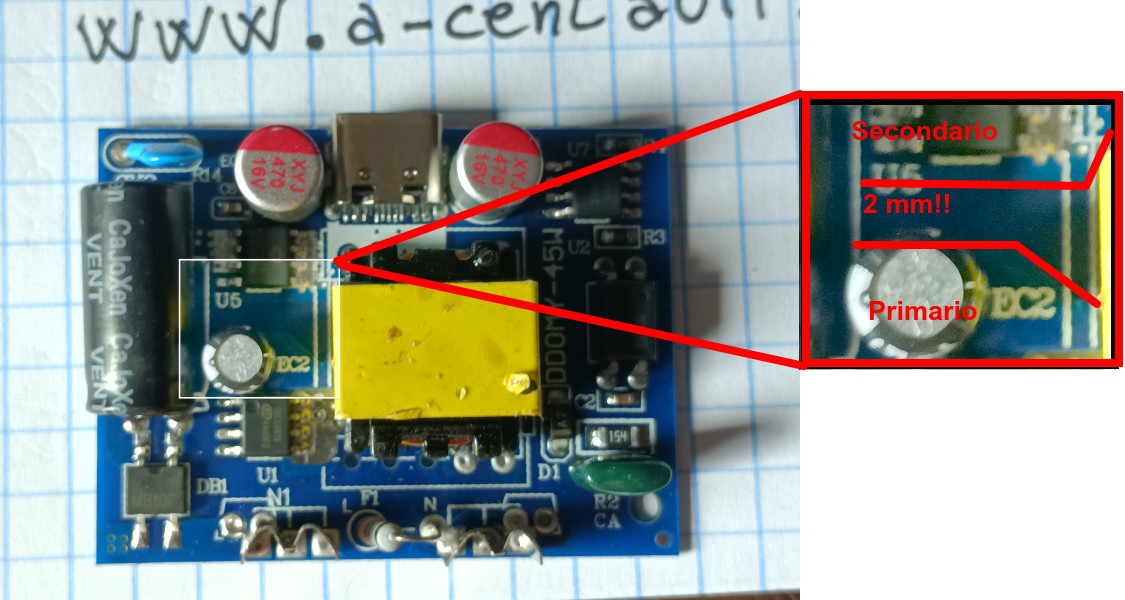
Choice of components
The chips used are:
- SDC5433Q: USB-C negotiation chip. Maximum power 20W, maximum voltage 16V (!)
- SDC5091: monolithic chip for SMPS (on the primary). Maximum power 22.5W (no, not even the 33W advertised by USB-C PDO are real!)
- DP4110: synchronous rectifier.
As you can see, with such a choice of components, it is impossible to believe that it is a defective model. The power supply was actually designed with the intent to scam people.
Such a scam is very difficult to notice, without the appropriate equipment and without a good knowledge of how USB-C works.
Interference filter
There is no interference filter, therefore the power supply produces vast quantities of RFI and totally kills the reception of a few weak FM stations (I'd rather not test it with 137 MHz satellites...)
Electrical safety
There is no fuse, and the resistor used as a fuse (F1) is not the safety fusible resistor type. The capacitor between the primary and secondary (CY) is a normal 100nF 1kV, despite the blue color, and is not the self-healing type that should be used.
This means that if the CY capacitor were to short, the entire USB port would be at mains voltage, along with any devices connected to it. A user holding a phone that was charging during such an event would undoubtedly receive a very strong and potentially fatal electric shock.
USB Cable
I originally wrote that the USB cable that comes with the power supply is 5 amps. The connectors on the cable itself also say 5A. Is that true?
The USB Power Delivery (PD) specification states that all USB-C to USB-C cables must be capable of carrying at least 3 amps, and these cables are defined as passive. Cables that can handle more than 3A must have a special chip, called an e-marker, inside them. The chip takes power and communicates via the CC pin of the USB-C connector. If the cable is connected to a power supply that can supply more than 3A, the load will first have to check for the e-marker, read its data, and then request a current higher than 3A from the power supply.
Of course (surprise!) our "5A" cable does not contain the e-marker, so it will never be able to carry 5 amps.

Conclusion
The power supply in question appears to be a clone of the SAMSUNG EP-TA845. You should buy power supplies ONLY from reliable stores, which basically means ONLY from the manufacturer's store. Even when buying from physical stores (not only discount stores, but even name-brand stores...) it is very, very likely to run into similar scams.
Power supplies of this kind, in addition to the obvious risks for people due to poor or non-existent galvanic isolation, also can harm the devices connected to them, produce interference that makes TV/radio reception difficult and often overheat and can catch on fire.
Appendix
Seller's reaction
As usual when I find myself faced with similar situations, I immediately contacted the seller sending comprehensive documentation (the same photos that are in this article, minus those of the disassembly obviously).
The answer was... "funny" (in Italian sadly)...

A long discussion follows with the seller who proceeds to:
- Deny that the power supply delivers less than the nominal power
- Confirm that it only delivers 33W, but that it would not change anything (my laptop does not charge with only 12V...)
- Categorically deny that the power was lower than advertised, because «I have a thousand positive reviews»
- Confirm that it only delivers 33W, but that «since you are nitpicking for 12W, you pay for the return»
- Confirm that it only delivers 33W, but that: «since math is not an opinion then you are entitled to a partial refund of (45-33)/100» (who cares if the power supply gives you a shock)
- Deny that he got a shock because «if it did give shocks then I would have had more negative reviews»
- Confirm that it only delivers 33W, but that «nothing changes with respect to the charge process so you pay for the return» (I wonder what his reaction would be if a grocer tried selling him a kilo of potatoes but charged him for 2 kilos!)
- Gave me my money back without returning anything (on paypal) after I point out to him that many of his reviews are quite negative, for example as follows:

After a few hours, I received this message. Who knows, maybe he realized that scams work until you find someone more experienced than you who catches you out? The reader will have to decide...
